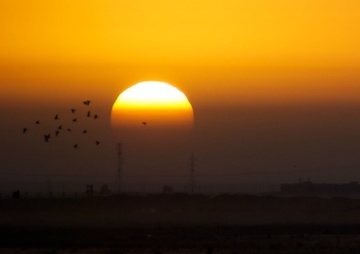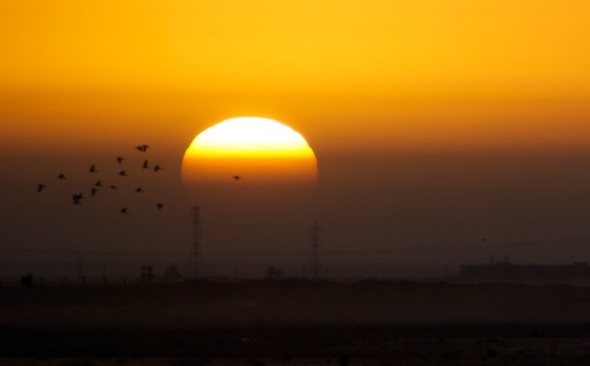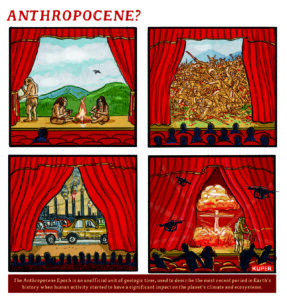Searing Heat May Spark Climate Exodus
Temperatures in the Middle East and North Africa could reach unbearably high levels that would make some regions uninhabitable and increase the pressure on climate refugees.
By Tim Radford / Climate News Network

The rising sun is partially obscured by a dawn dust storm in Iraq. (Elliott Plack via Flickr)
This piece first appeared at Climate News Network.
LONDON — Parts of the Middle East and North Africa could become unbearably hot if greenhouse gas emissions continue to rise.
New research predicts that, by mid-century, summer temperatures will stay above 30°C at night and could rise to 46°C during the day. By the end of the century, maximum temperatures could reach 50°C, and this could happen more often. Instead of 16 days of extreme heat, there could be 80 days.
“In future, the climate in large parts of the Middle East and North Africa (MENA) could change in such a manner that the very existence of its inhabitants is in jeopardy,” says Jos Lelieveld, director of the Max Planck Institute for Chemistry in Mainz, Germany.
He and colleagues report in Climatic Change journal that they used computer models to explore changes in temperature patterns in the MENA region in the 21st century. Global warming happens unevenly, and many regions are experiencing warmer winters — with earlier growing seasons — but not necessarily many more extremes in summer heat.
Sweltering days
But the pattern around the Eastern Mediterranean and in the landscapes of Egypt, Libya, Algeria, Tunisia and Morocco is one of increasing summer heat.
Between 1986 and 2005, the average number of “very hot” days was 16. By mid-century, this could reach 80 days a year. By the end of the century, even if greenhouse gas emissions decline after 2040, the number of sweltering days could soar to 118.
“If mankind continues to release carbon dioxide as it does now, people living in the Middle East and North Africa will have to expect about 200 unusually hot days, according to the model projections,” says Panos Hadjinicolaou, associate professor at the Cyprus Institute and a co-author of the report.
Prof Lelieveld and another co-author from the Cyprus Institute took part in a study of changing atmospheric conditions, to see what aerosol concentrations in the atmosphere could tell climate science about soil moisture trends in the region’s arid landscapes.
“Prolonged heatwaves and desert dust storms can render some regions uninhabitable, which will surely contribute to the pressure to migrate.”
They report in the Atmospheric Chemistry and Physics journal that as soils have dried, dust emissions have increased — by 70% over Saudi Arabia, Iraq and Syria since the beginning of this century.
Climate researchers have repeatedly warned that extremes of heat will become the “new normal” at most latitudes. However, those countries that already experience the most relentless summer heat could become increasingly unhealthy and unstable.
Extremes of drought have been linked to the fall of ancient civilisations in the region, as well as to the present conflict in Syria and to the growth in the refugee population in Europe and the Middle East.
Near-lethal conditions
One research team recently took a close look not just at heat but at potential humidity levels around the Gulf, and found that conditions could in some circumstances one day become near-lethal. So the latest studies are more confirmation than revelation.
The researchers considered what would happen if the world adopted the notorious “business-as-usual” scenario and did nothing significant to control greenhouse gas emissions.
They also considered a scenario in which the world tried to contain global warming to a 2°C average above historic levels, and in which global emissions began to decrease by 2040. But, even under this scenario, summer temperatures in the region would get to 46°C by mid-century.
“Climate change will significantly worsen the living conditions in the Middle East and in North Africa,” Professor Lelieveld says. “Prolonged heatwaves and desert dust storms can render some regions uninhabitable, which will surely contribute to the pressure to migrate.”
Tim Radford, a founding editor of Climate News Network, worked for The Guardian for 32 years, for most of that time as science editor. He has been covering climate change since 1988.
Your support matters…Independent journalism is under threat and overshadowed by heavily funded mainstream media.
You can help level the playing field. Become a member.
Your tax-deductible contribution keeps us digging beneath the headlines to give you thought-provoking, investigative reporting and analysis that unearths what's really happening- without compromise.
Give today to support our courageous, independent journalists.









You need to be a supporter to comment.
There are currently no responses to this article.
Be the first to respond.